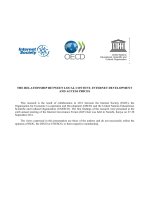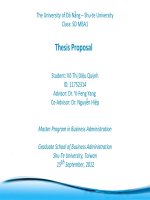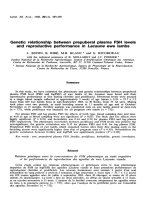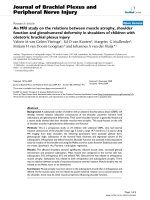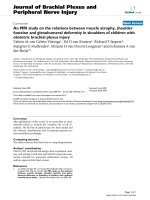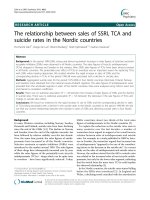The relationship between service quality customer satisfaction and customer loyalty in cleaning serviec industry
Bạn đang xem bản rút gọn của tài liệu. Xem và tải ngay bản đầy đủ của tài liệu tại đây (1.77 MB, 86 trang )
MINISTRY OF EDUCATION AND TRAINING
UNIVERSITY OF ECONOMICS HOCHIMINH CITY
……………………
Hunh Th Ngc Mai
An evidence of Pan Pacific Corporation
MASTER’S THESIS
Major: Business Administration
Major Code: 60.34.05
Supervisor
Dr. Trn Hà Minh Quân
Ho Chi Minh City 2010
ACKNOWLEDGEMENT
I would like to record my most sincere appreciation and heartfelt thanks to
individuals, of whom without, might not lead to the possibility of this research to be
realized. First and foremost, I wish to express my deep sincere gratitude to my
supervisor Dr.Tran Ha Minh Quan for his guidance, encouragement and excellent
advices throughout this study.
I would like to extend my sincere thanks to assistant Prof. Nguyen Dinh Tho,
Dr.Nguyen Thi Mai Trang and Dr.Dinh Cong Khai for their valuable comments and
constructive suggestions.
I would also like to avail this opportunity to express my appreciation to
Professor Nguyen Dong Phong and UEH Board of Directors for creating MBA
program in English.
I am also thankful to all my classmates in MBA class-Bath 16, especially
Ms.Nguyen Nhu Chang, Mr.Nguyen Thanh Trung, Mr.Lam Hong Phong, for their
collaboration and valuable assistance throughout my study.
Gratitude also goes to Board of Management of Pan Pacific Corporation,
colleagues for giving me supports. Many thanks for Pan Pacific’s Clients who save
value time to respond my survey questionnaire, without them my thesis could not
have been done.
Last but not least, the express my profound gratitude to my beloved mother,
my lover and my closest friends for being patience and never failed giving me
continuous supports, spiritually and encouragement along the study.
i
ABSTRACT
In the present cleaning service industry, service quality is a vital competitive
policy to keep customers support and long-term cooperation. Cleaning service
providers are trying to win customer satisfaction and loyalty by proving enhanced
quality service. The aim of this study is to examine the relationship between service
quality, customer satisfaction and customer loyalty in cleaning service industry. In
this study, attention is paid to the measurement model of service quality in cleaning
service industry based on the well-known SERVQUAL model, but with
modification on the basis of focus group discussions and expert opinions to reflect
the specific industry attributes and the special culture of Vietnam. 158 samples were
collected from Pan Pacific Corporation’s various clients in the South of Vietnam.
Cronbach Alpha was carried out to test the reliability of each statement and the
summated scales were formulated by means of Exploratory Factor Analysis (EFA).
Then, Multiple Linear Regressions test was used to test the effect of Service Quality
on Customer Satisfaction and Customer Loyalty, the effect of customer satisfaction
on loyalty. Overall findings from this study suggest there were significant
relationship between Service Quality, Customer Satisfaction and Customer Loyalty.
The study found that there were six dimensions of cleaning service quality
including affectivity, cleaner competence, supervisor competence, tangibles, service
safety, empathy and all dimensions are positively related to Customer Satisfaction.
The regression test also found that there was a positive direction and significant
relationship between customer satisfaction on customer loyalty. The results
indicated that the overall service quality has significantly positive effect on overall
customer loyalty. Among these six dimensions except Empathy, all of them have a
significantly positive effect on overall customer loyalty.
Keywords: cleaning service industry, service quality, customer satisfaction,
customer loyalty.
ii
TABLE OF CONTENT
ACKNOWLEDGEMENT i
ABSTRACT ii
TABLE OF CONTENT iii
Chapter 1: INTRODUCTION 1
1.1 Introduction about cleaning service industry 1
1.2 Research background: 2
1.3 Research problem 4
1.4 Research Questions 5
1.5 Objectives of the study 5
1.6 Scope of the Study 5
1.7 Research method 6
1.8 Structure of the study 6
Chapter 2: LITERATURE REVIEW 8
2.1 Service quality 8
2.2.1 Definition of service quality 8
2.2.1.1 Definition of “Quality” 8
2.2.1.2 Definition of “Service” 9
2.2.1.3 Definition of “service quality” 11
2.2.2 Measurement of service quality 11
2.2.3 Cleaning service quality 16
2.2.3.1 Definition of “Cleaning” 16
2.2.3.2 Definition of cleaning service quality: 16
2.2.3.3 Determinants of cleaning service quality: 17
2.2.3.4 Cleaning quality awareness 20
2.2 Customer satisfaction 23
2.3 Customer loyalty 24
iii
2.4 Relationship between service quality, customer satisfaction and loyalty 25
2.5.1 Relationship between Service quality and customer satisfaction 25
2.5.2 Relationship between Customer Satisfaction and Loyalty 26
2.5.3 Relationship between service quality and customer loyalty 27
Chapter 3: RESEARCH METHODOLOGY 29
3.1 Research design 29
3.2 Item generation 31
3.3.1 Items to measure Service Quality 32
3.3.2 Items to measure customer satisfaction 33
3.3.3 Items to measure customer loyalty 35
3.3 Preliminary study 35
3.4 Theoretical Model 37
3.5 Main survey 37
3.5.1 Sampling 37
3.5.2 Sample size 38
3.5.3 Survey method and data collection 39
3.6 Data Analysis techniques 39
Chapter 4: DATA ANALYSIS AND RESEARCH FINDINGS 41
4.1 Descriptive statistics of sample 41
4.2 Descriptive Analysis 44
4.3 Scales assessment 44
4.4.1 Reliability Analysis Results 44
4.4.2 Exploratory factor analysis (EFA) 46
4.4.2.1 Measurement scales of cleaning service quality 46
4.4.2.2 Measurement scales of customer loyalty 51
4.4.3 Adjustment of theoretical model 54
4.4 Testing the research model and the hypotheses 55
iv
4.4.1 Testing correlations between all constructs 55
4.4.2 Testing hypotheses 56
4.4.2.1 The relationship between Cleaning Service Quality and Customer
Satisfaction
56
4.4.2.2 The relationship between Customer Satisfaction and Loyalty…………58
4.4.2.3 The relationship between cleaning service quality dimensions and
customer loyalty 60
4.5 DISCUSSION AND FINDINGS 63
Chapter 5: CONCLUSIONS AND IMPLICATIONS 65
5.1 Conclusions of the study 65
5.2 Implications of the study 66
5.2.1 Theoretical implications 66
5.2.2 Practical implications 66
5.3 Limitations and recommendations for further research 68
APPENDIX 1- CUSTOMER SATISFACTION FEEDBACK 69
Vietnamese 73
English 73
SOME ACTIVITIES OF CLEANING SERVICES FOR REFERENCE 76
v
LIST OF TABLES
Table 3.1- Measurement scales of cleaning service quality 34
Table 3.2- Measurement scales of customer loyalty 35
Table 4.1- Sample characteristics 41
Table 4.2- Descriptive Statistics 44
Table 4.3 – Reliability of the measurement instrument 46
Table 4.4 – Rotated component matrix of cleaning service quality scale 50
Table 4.5 – Total Variance Explained of customer loyal 51
Table 4.6 – EFA result for individual measurement scales 52
Table 4. 7-Final construct measurement scales 52
Table 4.8- Summary of hypotheses 55
Table 4.9– Correlation matrix 56
Table 4.9a- Model Summary (cleaning service and customer satisfaction) 57
Table 4.9b – Coefficients 58
Table 4.10a-Model Summary ( customer satisfaction and customer loyalty) 58
Table 4.10b – Coefficients 60
Table 4.11a - Model Summary ( service quality and customer loyalty) 61
Table 4. 11b – Coefficients 61
vi
LIST OF FIGURES
Figure 2.1- SERVQUAL gap analysis 13
Figure 3.1-Research process 31
Figure 3.2 - Theoretical Model 38
Figure 4.1a - Position of respondents 42
Figure 4.1b-Gender of respondents 43
Figure 4.1c - Service range of respondents 43
Figure 4.2 - Adjusted theoretical model 54
Figure 4.3- Hypothesis H1 testing result 58
Figure 4.4-Hypothesis H2 testing result 60
Figure 4.5 -Hypothesis H3 testing result 62
vii
Chapter 1: INTRODUCTION
This chapter begins with general introduction about cleaning service and the
current study is provided with research background, research problem, research
objectives and research questions are mentioned as the rationale for this study.
Also, scope of the current study are discussed and an introduction of the
methodology to be used in this chapter. At the end of the chapter, the structure of
this study is provided.
1.1 Introduction about cleaning service industry
Nowadays, cleaning service is very popular in human life. Cleaning service
providers is responsible for providing all necessary management, manpower,
machinery, equipment, tools, chemicals (exclusive such items, which the Landlord
shall provide), which were pre-approved by the Landlord to efficiently carry out the
cleaning tasks of the project in accordant with the international standard and
Landlord requirements. They also provides uniformed, properly trained and
appropriately skilled cleaners. All cleaners have a yearly health check. Cleaners
shall at all time while on duty be dressed in full uniform, well groomed, clean-
shaven, polite and helpful. Service providers maintains the minimum number of
contracted cleaners and provides additional cleaners as it determines necessary for
full cleaning coverage during sickness, holidays, etc.
Using cleaning service bring to us much advantage : high quality service,
reasonable fee, the professional and well trained working force from the leading
company in cleaning and property care, the modern specific cleaning equipments
without any investment, maintaining the value of the property, creation a clean and
beautiful working environment for both officers and visitors, avoidance from
directly management to the cleaning workers and risks from its potential problems,
whole hearted concentration on own business.
1
Among of many cleaning service providers in Vietnam, Pan Pacific is one
leading company in this industry, with operating in over 20 cities and provinces
nationwide, supplying cleaning service for more than 300 customers of many
business types. Pan Pacific also is among of Vietnam largest cleaning providers
with over 5000 skilled employees. With more than 17 years experience in cleaning
service industry, Pan Pacific has developed various customer system including
Commercial Buildings (office buildings, service apartments), Supermarkets and
Shopping Centers, Hospitals & Medical Centers, Factories in IPs, EPZs,
International Schools. Especially, Pan Pacific also have many experiences in
supplying regular cleaning service for typical projects with highest level national
security such as; International Airports, Television Station.
1.2 Research background:
Going with developing real estate market and foreign investment, demand of
facility management in office buildings, shopping centers, international schools,
foreign factories are appeared. These management services include security,
property maintenance, pest controls, landscape and cleaning service. In which
cleaning service industry is very important to enhance quality and brand of the
building.
Instead of organizing and managing a cleaning division, owners can contract
with professional cleaning company which can provide package service including
manpower, equipments, tools, chemicals. A cleaning company will provide
uniformed, properly trained and appropriately skilled cleaners, all cleaners have a
yearly health check, cleaners shall at all time while on duty be dressed in full
uniform, well groomed, clean-shaven, polite and helpful. Cleaning company will
provide additional cleaners as it determines necessary for full cleaning coverage
during sickness, holidays, etc. Cleaning company also is responsible compensating
damage of property which cause of their employees.
2
With lot of advantages bring to customer, industry cleaning service is first
choice for Office Buildings, Shopping Centers, Shopping Malls, Foreign Factories,
International Schools….By outsourcing, the owner can save their time to
concentrate main business fields.
Therefore, cleaning service industry in Vietnam has developed rapidly in
recently year with a lot of customers in many fields such as : almost Office
Buildings with grade A-B-C have demand of using high-class cleaning service
(Bitexco Financial Tower, Saigon Centre, Metropolitan, Sunwha, Kumho…),
famous shopping centers (Diamond, Parkson,…), modern factories in electricity,
pharmacy, food (Intel, P & G, Unilever, Kimberly Clack, Sanofi, Sonion…),
international schools (VUS, VAS, ACG, RMIT, V-STAR, Bc M, Vit M,
Saigontech …), high-class service apartments (The Manor, Saigon Pearl, Somerset,
Catavil…), Hotels ( Sheraton, Rex, Kumho, ). Number of cleaning providers also
increase quickly to meet market demand. In the such competitive market,
developing and keeping customer loyalty is essentially for business survival.
Customer loyalty is another way to gain the best possible customer, repeat
customers. Not only do repeat customers tend to spend more money but they are
often the people who tend to provide the best word of mouth advertising possible.
Especially in cleaning service industry, competition is rife. Customer will not
hesitate to terminate cleaning contract in the event that their needs and expectations
are not met. In cleaning service, emphasis on the quality is a vital aspect in that it
determines the level or degree of customer satisfaction. A cleaning service provider
can reduce the detrimental impact of effective factors by first ensuring that its
customers are as highly satisfied with its services as possible.
Cleaning service organizations are better positioned to reap the positive
outcomes associated with having a largely satisfied customer base if they have an
understanding of those factors that contribute to their customers’ satisfaction.
Because meeting customers' expectations for key service quality attributes should
3
lead to satisfied customers who, in turn, will remain loyal to the service and
recommend it to other potential customers.
1.3 Research problem
To evaluate how well their companies are meeting customer needs, service
managers often use measurements of service quality and customer satisfaction
(Dabholkar, 1995). Therefore, service quality and customer satisfaction have
received much attention from service marketers and academic researchers (Spreng
& MacKoy, 1996). In addition, Taylor (1997) has noted that the two constructs
(service quality and customer satisfaction) have became very important for
marketing theory and practice.
Oliver (1997) suggested that profit for a company (purchase/repurchase
behavior by the consumer) was dependent on a sequence of three factors: Quality,
satisfaction, and loyalty. Quality has a direct influence on consumer satisfaction,
which can be both a cognitive and affective dimension according to Oliver.
Satisfaction, in turn, has a direct influence upon the loyalty of the consumer.
A review of available literature found a lot of studies regarding
interrelationship of service quality on customer satisfaction and customer loyalty.
But it is lacking in studies of cleaning service, there is only one published study
(Anthony M Kyengo, April 2007) examine quality control in cleaning service.
In this circumstance, not only Pan Pacific but also Vietnamese cleaning service
companies realize the necessity of empirical studying to examine specifically
influences of their service to customers’ behavior. They need know that, what specific
aspects of their services influence customers in terms of their satisfaction and their
perceptions of service quality, which, in turn, lead to customer loyalty?
4
1.4 Research Questions
Base on the above stated research problem the following research questions have
been developed:
Q.1 What are the service quality dimensions in cleaning service industry.
Q.2 How do the dimensions of service quality effect on customer satisfaction,
customer loyalty in cleaning service industry.
Q.3 Is there any significant relationship between customer satisfaction and
customer loyalty in cleaning service?
1.5 Objectives of the study
The objectives of this study are to:
• Explore the relationship between the components of service quality with
customer satisfaction and customer loyalty.
• Explore the relationship between customer satisfaction and customer loyalty.
1.6 Scope of the Study
In general Pan Pacific Corporation provides three types of core services to
their customers such as cleaning service, pest control service and laundry service,
with activities spreading from the North, the Middle to the South of Vietnam. In
which, most of current customers concentrate on cleaning service. For the purpose
of this study, the study will focus particularly in the areas of cleaning service
offered by Pan Pacific which is leading company in cleaning service industry. In
addition, customer information from other competitors is usually confidential and
hard to obtain. The respondents of the research was categorized to those current
customers who use the services directly.
5
1.7 Research method
This study was conducted with two stages:
• A preliminary study: in the first stage, a qualitative approach was applied
in order to explore whether the scale for measuring cleaning service
quality. This step was carried out by using group discussion techniques.
• The main study: A quantitative approach was used to examine research
questions. Data were collected by using survey questionnaire Pan Pacific’s
customers and SPSS software version 16 was used for data analysis.
Cronbach’s Alpha test was carried out to test the reliability of the
measurement scales, and then using Exploratory Factor Analysis (EFA). The
research model and hypotheses were tested by using Multiple Linear
Regression analysis (MLR).
The methodology for this study will be come back with more detail Chapter 4.
1.8 Structure of the study
• Chapter 1 will discuss on the research background, research problem,
objectives of the study, scope and method of the research. Pan Pacific
Corporation are also mentioned in the chapter as a glance.
• Chapter 2 describes about various reviews on past literatures which
discussed about service quality, customer satisfaction and customer loyalty
and their relationship.
• Chapter 3 explains how the research methodology, the development of the
hypotheses, data collections and the types of data analysis have been carried
out to make sure all the data are reliable and the findings are valid.
6
• Chapter 4 will discuss on research results in detail, describes sampling and
processing data, presents analyzing the data collected and the findings of
the study.
• Chapter 5 will conclude and recommend the findings. The findings of the
research are expected to give guidance to cleaning service companies in
prioritized their service.
7
Chapter 2: LITERATURE REVIEW
This chapter will give an overview of literature review and models that are
related to the research problem presented in the previous chapter. In this chapter the
concepts of service quality, customer satisfaction, customer loyalty and relationship
of them will be introduced. The aim of this review is to generate hypotheses that
will be tested in the cleaning service to answer the research questions and to
confirm the research model. Additional, details of cleaning service quality literature
is also mentioned in this chapter.
2.1 Service quality
2.1.1 Definition of service quality
2.1.1.1 Definition of “Quality”
To understand what “Service Quality” is, we need to understand what is
“Quality” and it’s concept as a whole. Understanding the term “Quality” will reveal
that the concept has been defined in many different ways and with different
emphasis by the various quality gurus and writers on the subject. Quality is an
elusive and indistinct construct. Often mistaken for imprecise adjective like
“goodness, or luxury, or shininess, or weight” (Crosby 1979), quality and its
requirements are not easily articulated by consumers (Takeuchi and Quelch 1983).
Quality has been defined (Taylor and Baker, 1994) as superiority or excellence
(Zeithaml, 1988), or as the consumer’s overall impression of the relative
inferiorityor superiority of a service provider and its services (Bitner & Hubbert,
1994; Keiningham et al., 1994/1995).
Most of the efforts in defining and measuring quality are coming from the
goods sector. According to the prevailing Japanese philosophy, quality is “zero
defects – doing it right the first time”. However, understanding of quality in goods
and its importance is not sufficient to understand service quality.
8
2.1.1.2 Definition of “Service”
A service is an economic activity that produces time, place, form, or
psychological utility. Four well documented characteristics of services –
intangibility, heterogeneity, perishability and inseparability – must be
acknowledged for a full understanding of service quality (Parasuraman, Zeithaml
and Berry 1985) :
Intangibility
Services are activities or benefits or benefits that are essentially intangible,
cannot be prefabricated in advance and do not involve ownership of the title (York,
1993). They may include the traditional personal assistance service, for instance,
baby-sitter, gardener etc. The fix it service such as mechanic, repairman, etc. and
finally the value added service as the least tangible of all (Cotter, 1993). Most
services are intangible (Bateson 1977,Berry 1980, Lovelock 1981, Shostak 1977).
Because they are performances rather than objects, precise manufacturing
specifications concerning uniform quality can rarely be set. Most services cannot be
counted, measured, inventoried, tested and verified in advance of sale to assure
quality (Parasuraman, Zeithaml and Berry 1985). Because service is not an object
but a phenomenon, it is difficult for customers to evaluate the quality of services as
they evaluate physical goods. Because of intangibility, the firm may find it difficult
to understand how consumers perceive their services and evaluate service quality
(Zeithaml 1981).
Heterogeneity
Services, especially those with high labor content, are heterogeneous; their
performance often varies from producer to producer, from customer to customer,
and from day to day (Parasuraman, Zeithaml and Berry 1985). Consistency of
behavior from service personnel (ie. uniform quality) is difficult to assure (Booms
9
and Bitner 1981) because what the firm intends to deliver may be entirely different
from what customer receives.
Inseparability
Production and consumption of many services are inseparable (Carmen and
Langeared 1980, Gronroos 1978, Regan 1963, Upah 1980). Services involve
simultaneous production and consumption. Inseparability implies that service is
simultaneously produced and consumed while physical goods are first produced,
then sold and finally consumed. Inseparability of production and consumption often
forces the involvement of the customer in the production process. Inseparability
also means that the producer and the vendor often compromise one economic entity
(York 1993). In labor intensive services for example, quality occurs during service
delivery, usually in an interaction between the client and the contact person from
the service firm (Lehtinen and Lehtinen 1982). In this situation, the customer input
becomes critical to the quality of service performance.
Perishability
The inseparability of production and consumption in turn results in an
inability to store service capability. Perishability means that services cannot be
produced in advance, inventoried and later made available for sale. Services are
performance that cannot be stored (Zeithaml, 1998). It is often difficult to
adequately match up with demand and supply such as those corrective maintenance
works, for instance, heating and cooling repairs.
In conclusion, base on the examination of those writing and other literature
reviews on services (Gronroos 1982; Lehtinen and Lehtinen 1982; Lewis and
Booms 1983; Saser, Olsen, and Wyckoff 1978) Parasuraman, Zeithaml and Berry in
1985 suggest three attributes of service quality:
10
• Service quality is more difficult for the consumer to evaluate than goods
quality.
• Service quality perceptions result from a comparison of consumer
expectations with actual service performance.
• Quality evaluations are not made solely on the outcome of a service; they
also involve evaluations of the process of service delivery.
2.1.1.3 Definition of “service quality”
Despite of all the debates, many researchers were traditionally agreed and
accepted that service quality is a comparison between expectations with perceptions
of performance. Perceived quality is the consumer’s judgment about an entity’s
overall excellence or superiority (Zeithaml 1987). It is clearly differs from objective
quality (as define by few researcher, for example, Garvin (1983) and Hjorth-
Anderson (1984)). Parasuraman et al (1985) defined service quality as “the global
evaluation or attitude of overall excellence of service”. So, service quality is the
difference between customers’ expectation and perceptions of services delivered by
service firms.
2.1.2 Measurement of service quality
Ducker (1991) defines service quality as “what the customer gets out and
is willing to pay for” rather than “what the supplier (of the service) puts in”.
Hence, service quality is often “conceptualized as the comparison of service
expectations with actual performance perceptions” (Bloemer, Ruyter et al. 1999;
Kara, Lonial et al. 2005). Service science literature often relies on SERVQUAL
as an instrument to measure quality of service provided. SERVQUAL scale
was developed based on a marketing perspective with the support of the Marketing
Science Institute (Parasuraman, Zeithaml et al. 1986). Previous research confirms
its use as applicable to healthcare environment (Babakus 1992; Dean 1999; Arasli,
11
Ekiz et al. 2008). For a thorough analysis of SERVQUAL see Nyeck et al.
(2002). SERVQUAL principle primarily relies on a gap model (Parasuraman,
Zeithaml et al. 1985) (Figure 2.2). Every gap in SERVQUAL has a unique role as
follows:
• Gap 1: difference between consumer expectations and management perceptions of
consumer expectations.
• Gap 2: difference between management perceptions of consumer expectations and
service quality specifications.
• Gap 3: difference between service quality specifications and the service actually
delivered.
• Gap 4: difference between service delivery and what is communicated about the
service to the consumer.
• Gap 5: difference between consumer expectations and perceptions.
The construct of service quality as conceptualized in the service marketing
literature centers on perceived quality, defined as a consumer’s judgment about an
entity’s overall excellence or superiority (Parasuraman et al., 1988; Zeithaml, 1988;
Bitner, 1990). In other words, Service quality can be defined as a measure of how
well the service delivered matches the customer expectation of the service Gronroos
(1982) considers services as products requiring, to a large extent, the consumer’s
involvement in the process of production and consumption, during which
consumers compare their expectations about the service with what they actually
receive. The result of this comparison is perceived service quality (Parasuraman et
al., 1985, 1988).
Therefore, it is how customers perceive the quality of service that should be of
key concern to managers. To assist managers in understanding their customers'
12
perceptions of quality, Parasuraman et al. (1988) devised the SERVQUAL
instrument. This instrument is intended to capture the range of attributes
important to consumers of a service.
Figure 2.1- SERVQUAL gap analysis
Word of mouth
comunications
Personal need
Management
Perception of
Customer Expectation
Service delivery
(including pre and
post- contacts)
Perceived Service
Expected Service
Translation of
Perception into
Service Quality spec.
External
Communication to
Customer
CUSTOMER
PROVIDER
GAP 4
GAP 2
GAP 3
GAP 5
GAP 1
Past Experience
Source: (Parasuraman, Zeithaml et al. 1985)
13
Originally Parasuraman et al. (1985) identified ten general dimensions of
service quality such as responsiveness, competence, access, courtesy,
communication, credibility, security, understanding, knowing the customer and
tangibility, but as a result of succeeding research, these were collapsed into five
dimensions (Parasuraman et al., 1988, 1991) that link specific service
characteristics to consumers’ expectations as follows:
a) Reliability : ability to perform promised service as dependably and
accurately
b) Responsiveness :
Willingness to help customers and provide prompt service.
c) Assurance. Knowledge and courtesy of employees and their ability to
inspire trust and confidence.
d) Empathy: Ability to be approachable and also service aspect that stresses the
treatment of customers individuals
e) Tangibles : focus on the elements that represent the service physically (
physical facilities, equipment, and appearance of personnel;)
Service quality
Parasuraman et al. (1988)
Reliability
RELI1. Providing services as promised
RELI2. Dependability in handling customers' service performed
RELI3. Performing the services right the first time
RELI4. Providing services at the promised time
14
RELI5. Keeping customers informed about when services will be performed
Responsiveness
RES1.Prompt service to customers
RES2. Willing to help customers
RES3. Readiness to respond to customers' requests
Assurance
ASS1. Employees who instill confidence in customers
ASS2. Making customers feel safe in their transaction
ASS3. Employees who are consistently courteous
ASS4. Knowledgeable employee to answer customer questions
Empathy
EMP1. Giving customers individual attention.
EMP2. Employees who deal with customers in a caring fashion
EMP3. Having the customer's best interest at heart
EMP4. Employees who understand the needs of their customers
Tangibles
TANG1. Modern equipment
TANG2. Visually appealing facilities
TANG3. Employees who have a neat, professional appearance
15
TANG4. Visually appealing materials associated with the service
TANG5. Convenient business hour
2.1.3 Cleaning service quality
2.1.3.1 Definition of “Cleaning”
Cleaning is a part of a facility maintenance activity that aim at increasing and
maintaining the overall life cycle of the facility and, at the same provide a human
support for an effective working environment to facility’s occupiers.
Cleaning is a process that is systematic in nature and aim at the removal of
unwanted matter in our environment. The end result of cleaning is to ensure that
unwanted matter is cleaned and maintained to a certain safe degree zone that reduce
risk levels to human health. The cleaning process then need to be achieved by using
the highest degree of monitoring system or standard available the time. These
standard are controls, which are implemented in order to effectively achieve the
desired quality in the cleaning. That process of implementing and monitoring cam
then be classified as quality control (Anthony M,2007, 5).
2.1.3.2 Definition of cleaning service quality:
Cleaning service quality cannot be easily measured as it perceived different
by every individual. In most cases, Quality signifies excellence and reliability, but
again, this also defer from each customer’s point of view.
The term quality exists in many definitions and many scholars have
endeavored to define quality as it used in different context. In service operation,
quality can be defined as: “the right thing, as the right place, as the right time” (
wright 1999, 169). In management, quality is seen as “ meeting the customer
requirements” ( Oakland 1993,5)
16
In the cleaning industry, cleaning service quality is the ability to meet the
customer expectations and needs. If the customers’ s experiences of the cleaning
service correspond with his assumptions, then he consider the overall quality good
(huilaja 1998, 22).
Cleaning quality can also be defined and described as the extent to which the
cleaning upkeep satisfied and continues satisfy the requirements specified for the
use and function of the rooms (Bound 2002,10-11). The quality is good if the user
of the room in question are satisfied and remain so. This applies when the cleaning
can be carried out property, with the correct frequency and under normal conditions.
2.1.3.3 Determinants of cleaning service quality:
All business point of view, will ague that the customer is always right, In this
context, it means that the customer determines the quality of work. However, the
overall quality of cleaning service ( Bound 2002,10) is determined by :
• Cost (Price)
• Reliabilities of the service provider
• Responding to disasters and resolving complaints
• Customer need and expectations
• The organization’s principles and working mechanisms (the efficient of use
resources and technology, competition analysis )
• Cleaning quality
Cost/Price
In cleaning service, cost bear heavily in customer’s mind as it is used to
gauge the level of quality desired. The more the customer need and expectation are
17

